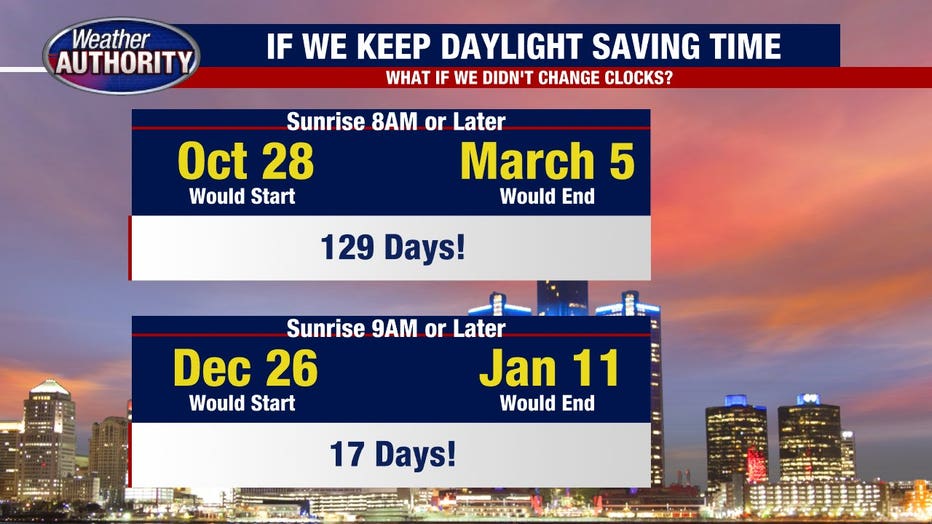What permanent daylight saving time means for Michigan

FILE - A clock face on display at the Clockmakers' Museum, part of the Science Museum in London.
(FOX 2) - Congress appears ready to abolish America's biannual time jumps. Are you?
What was originally enacted as a means to conserve energy but is now the poster child of disgruntled commuters and sleep-deprived parents, this year could be one of the last the U.S. winds their clocks back and forth to accommodate the seemingly arbitrary tradition.
On Tuesday, The U.S. Senate unanimously approved making daylight saving time permanent - a break from the political dysfunction that normally consumes the political body.
But what does it mean to abolish the longtime practice?
In Michigan, it would mean winter sunrises happening much later in the day.
Why do we have daylight saving?
Before it became a nuisance for people and an association with public health hazards, daylight saving time was implemented in the 1960s as a trick to conserve energy.
The idea behind the time jump, according to Vox, was that if the sun was setting later in the evening - say 8 p.m. instead of 7 p.m. - Americans would spend fewer hours with their lights on, and thus, save more energy.
There would also be less daylight that people would be asleep for. Those daylight hours would happen later in the day, which means people would be more awake for the day and spend more hours of darkness in bed.
RELATED: A little history on daylight saving time
But that result never panned out. People may have turned their lights off sooner, but heating and AC use climbed, studies showed.
Daylight saving becomes a public health hazard
It's not just energy usage that didn't pan out.
Studies show that TV ratings sink, but kids get less exercise, and workplace productivity falls. Traffic accidents and workplace injuries also climb when clocks spring forward in March, as do heart attacks.
RELATED: The best ways to prepare you body for the time jump
And then there's the confusion that a shorter or longer day your body feels when clocks spring forward or jump back.
What would permanent daylight saving look like?
Since daylight saving happens from March to November, a permanent version like that would primarily impact the winter months.
During the winter months, the sun wouldn't rise until 8 a.m.
On the shortest day of the year during the winter solstice, the sun rise wouldn't happen until 8:57 a.m and would set at 6 p.m. In other words, almost all days in the months November, December, January, and February would have sunrises after 8 a.m.
RELATED: How Michigan's sunrises and sunsets would change with daylight saving time
Those on the 9-5 work schedule would find that even the sun would be up when they got back from work, so their entire day at home wouldn't be spent in darkness. But, kids would also be getting on the school bus in the dark for much of the winter.

In fact, a lot of the morning work and driving that Michigan residents do would be done in the dark during winter months. Mornings would also be colder.
A previous version of this story misstated the time when the sun would rise in the summer under the proposed change.

